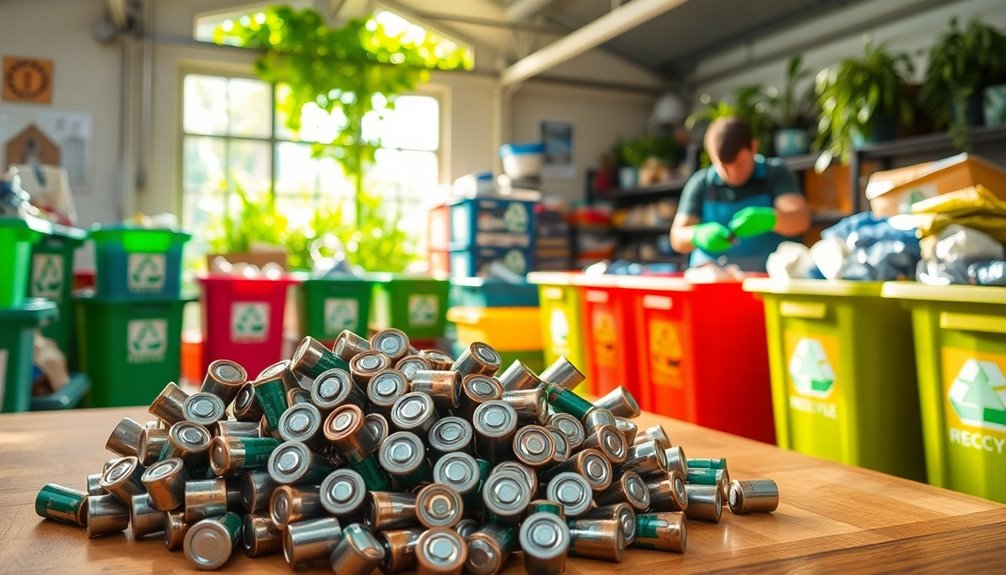To reduce the environmental footprint of battery supply chains, you should prioritize responsible sourcing, work with suppliers that follow strict environmental standards, and promote transparent, traceable supply chains. Adopt eco-friendly manufacturing processes that use renewable energy and circular economy principles, like recycling and reusing materials. Supporting robust recycling infrastructure and industry collaborations can further lessen ecological impacts. Keep exploring these strategies to discover more effective ways to minimize environmental harm throughout the supply chain.
Key Takeaways
- Implement responsible sourcing by working with suppliers adhering to strict environmental and social standards.
- Adopt eco-friendly manufacturing processes that minimize waste and use renewable energy sources.
- Enhance recycling infrastructure and design batteries for easier end-of-life material recovery.
- Utilize digital tools like blockchain to improve transparency and traceability across supply chains.
- Foster industry collaboration to develop sustainability standards and invest in recycling and resource recovery infrastructure.

As the demand for batteries continues to surge, it’s imperative to address the environmental impact of their supply chains. The extraction of raw materials, such as lithium, cobalt, and nickel, often leads to significant ecological damage, including habitat destruction, water pollution, and high carbon emissions. To mitigate these issues, you can prioritize sustainable sourcing practices that guarantee materials are obtained responsibly. This involves working with suppliers who adhere to strict environmental and social standards, reducing the negative effects of mining and extraction. By supporting transparent supply chains, you help promote responsible resource management and prevent illegal or unethical practices that harm ecosystems and communities.
Prioritize responsible sourcing to minimize ecological damage from raw material extraction.
In addition to sustainable sourcing, eco-friendly manufacturing processes play an indispensable role in reducing the environmental footprint of batteries. You should advocate for manufacturing techniques that minimize waste, lower energy consumption, and incorporate renewable energy sources. For example, integrating solar or wind power into production facilities substantially cuts down greenhouse gas emissions associated with battery manufacturing. Furthermore, adopting circular economy principles—such as recycling and reusing materials—can drastically reduce the need for new raw material extraction, conserving natural resources and decreasing pollution. Implementing AI security technologies can enhance monitoring and compliance of these sustainable practices across global supply chains.
Implementing eco-friendly manufacturing also involves designing batteries for longevity and recyclability. When batteries are built with end-of-life disassembly and material recovery in mind, it becomes easier to recycle valuable components, reducing the demand for virgin resources. This approach not only diminishes environmental harm but also supports a more sustainable supply chain by closing the loop on material use. You can collaborate with industry stakeholders to develop standards and infrastructure that facilitate efficient battery recycling, ensuring that toxic or hazardous waste is minimized during production and disposal.
Furthermore, transparency and traceability are fundamental in fostering sustainable practices. You should push for greater visibility into supply chain operations, ensuring that every step—from raw material extraction to final assembly—meets rigorous environmental criteria. Digital tools like blockchain can help track materials and verify compliance with sustainability standards, giving consumers and investors confidence that batteries are produced responsibly.
Ultimately, reducing the environmental footprint of battery supply chains is a collective effort. By championing sustainable sourcing, supporting eco-friendly manufacturing, and investing in recycling infrastructure, you play a pivotal role in making battery production more environmentally responsible. This not only benefits the planet but also creates a more resilient and ethical industry that can meet the growing global demand for clean energy solutions.
Frequently Asked Questions
How Can Consumers Influence Sustainable Battery Supply Chains?
You can influence sustainable battery supply chains through consumer activism by choosing products with ethical sourcing and transparent supply chains. Support brands committed to responsible practices, and voice your concerns about environmental impact. Your purchasing decisions encourage companies to prioritize sustainability, reducing harmful practices. By demanding ethical sourcing and transparency, you drive industry change and promote environmentally friendly practices across the battery supply chain.
What Are the Latest Innovations in Eco-Friendly Battery Materials?
You might not believe it, but the latest innovations in eco-friendly battery materials are transforming our future! Cutting-edge cathodes now use rare, sustainable minerals, drastically cutting environmental harm. Plus, biodegradable electrolytes are revolutionizing safety and sustainability, breaking down naturally without pollution. These breakthroughs could make your next phone or car battery much greener, helping you actively fight climate change. It’s a game-changer you won’t want to miss!
How Do Regulations Impact Global Battery Supply Chain Sustainability?
Regulations substantially shape your approach to making the battery supply chain sustainable. They enforce regulatory compliance, ensuring you follow environmental standards and avoid penalties. Additionally, policy incentives motivate you to adopt eco-friendly practices, like sourcing sustainable materials or reducing emissions. These rules and incentives encourage innovation and responsible sourcing, helping you lower your environmental footprint and align with global sustainability goals. Staying informed and adaptable is key to leveraging these regulations effectively.
What Role Do Recycling Programs Play in Reducing Environmental Impact?
Recycling programs play a vital role in reducing environmental impact by improving recycling infrastructure and waste management. When you participate in these programs, you help recover valuable materials from used batteries, decreasing the need for new resource extraction. This reduces pollution and energy consumption. Your involvement supports a circular economy, minimizes hazardous waste, and promotes sustainable battery production, making a significant difference in lowering the overall ecological footprint of battery supply chains.
How Does Supply Chain Transparency Improve Environmental Practices?
Supply chain transparency helps you improve environmental practices by addressing traceability challenges and ensuring ethical sourcing. When you have clear visibility into each step, you can identify and eliminate harmful practices, reduce pollution, and promote sustainable resource use. Transparency fosters accountability, enabling you to verify suppliers’ compliance with environmental standards and ethical standards, ultimately leading to a greener, more responsible battery supply chain that minimizes ecological harm and supports sustainable development.
Conclusion
By actively adopting sustainable practices, you can profoundly lower the environmental impact of battery supply chains. Think of it like trimming a tree—you need to prune carefully to let it grow healthier. Your efforts in sourcing responsibly, reducing emissions, and recycling materials make a real difference. Together, you can steer the industry toward greener horizons, ensuring a cleaner planet for future generations. Every small step you take is like a drop in an ocean of change.










